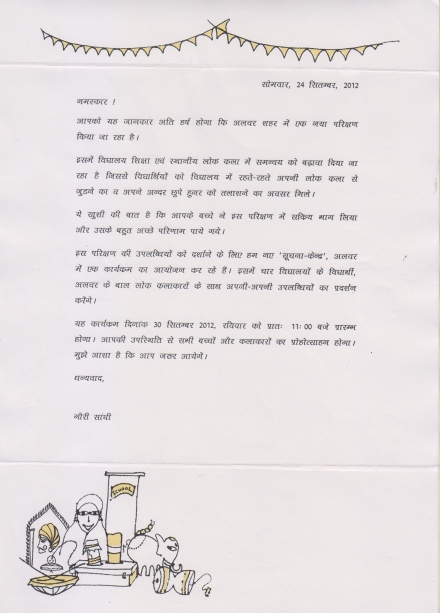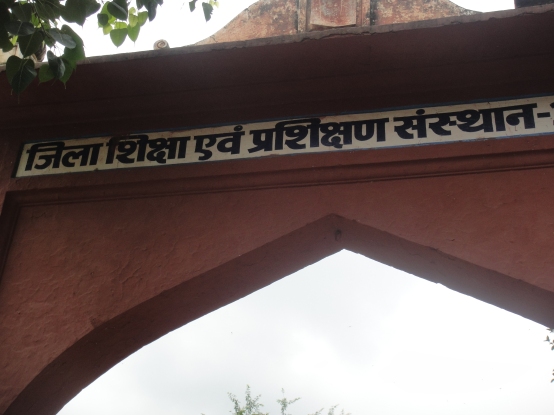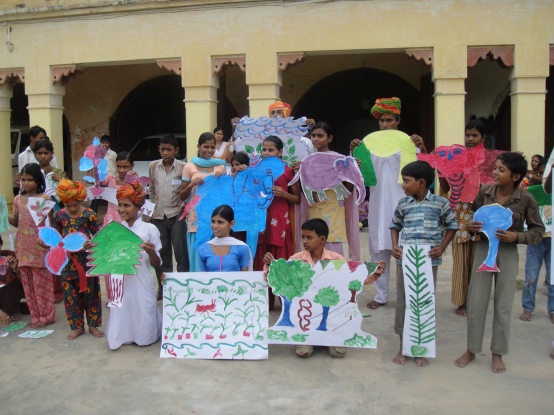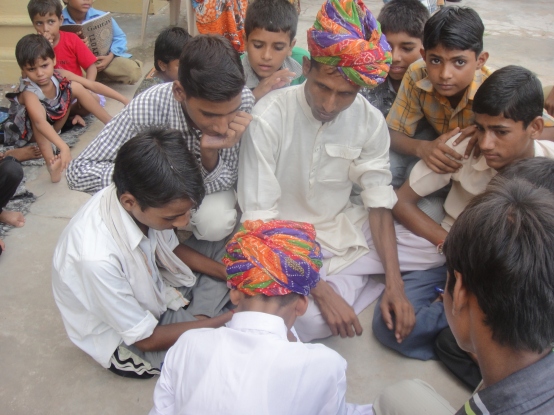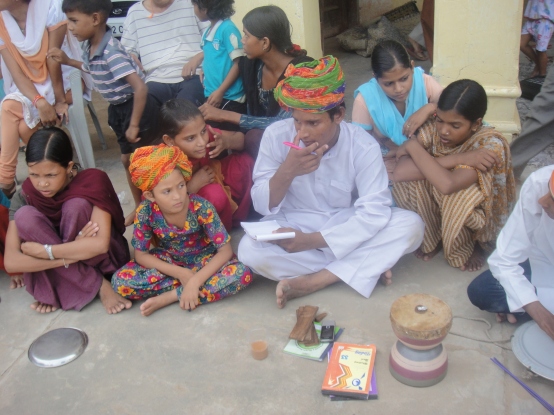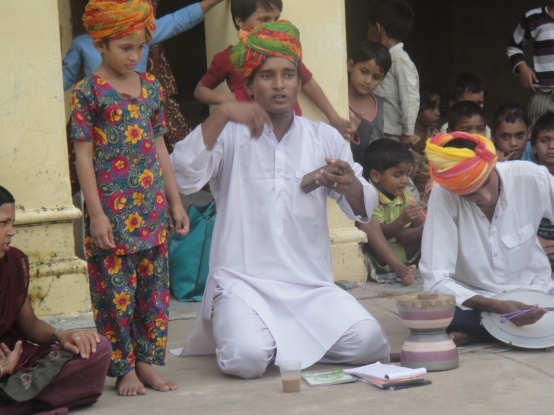<a href="http://” title=”the artist book”>
“Bhaya hum alwar se aye hain ” is a song that is running across all schools where we have done workshops. This song is first sung by the artists to introduce themselves. By the end of the last workshop, they add to the song , two stanzas about what they taught and learned in from the students. The students, on the other hand and asked to add two stanzas on their own about their experience of the workshop.
This is the fourth version of the song from Govt Secondary School, Railway Station, Alwar. We have three other versions of the songs from the previous schools.
This video was shot in Government Secondary School, Railway Station , Alwar. An example of how the students learn about rhythm with whatever they can find around them. The students were asked find objects around them with which they could create sound. The objective was to ’empower’ each student with an instrument of their own for the remaining workshop and help them overcome their hesitation and fear of creating music.
(empowerment is a new word I am adding to my project. Though this addition is probably in the last phase of this project, but it has come out of the experiences that the children shared from each of these schools where we have done our workshops.)
Doing a workshop at Mewat Baalika Avasiya Vidyalaya (Mewat residential school for girls) was the biggest challenge for the artists. Not only they had to interact with a group which consisted of only girls, but the girls are from their own community. It took a lot of conversations, arguments and breaking of pre conceived notions in the head to reach this stage where they were all set to go and meet these girls.
After the first workshop at this school I could see a huge difference in the confidence that the artists had. For the first time two of them said
mam ab hum kar sakte hain akele. Ab batao kya kaam karna hai.
One, of course they could do the workshop with these children and second just the fact that they could fight their own fear and hesitation has been a big boost to their energy levels and self confidence.
Mr. Pancholi is a member at the Government secondary school, Railway station in Alwar. I visited his school today to ask for permission to do a workshop with his students. One of the reasons why this school is important is that the school is around the village where the Artists come from. Many children from Mungaskhan village go to this school. In fact two of the artists themselves have studied in this school.
Mr. Pancholi as expected was somewhat vary of my intentions. The first question I was asked was that which organization do I belong to. And if I am doing this on my own then what is my intention behind this project. From his experience in working in Alwar and being closely associated with Mewati art and cultural activities, he thinks that most people who have come to Alwar to work with this community have “used” the children and have gone ahead and won awards. I think this conversation was very important for me since, while talking to him , I could re articulate my intentions and my stand in this project.
I told him how this is a student project where my motivation lies in applying my learnings in this local context. I am not claiming to preserve Mewati art and culture. My aim is to work with a group of these particular four artists and capacitate them to share the knowledge that they have. This is an experimental project, and if it is successful, It can be used as a model and built upon to be applied to other communities.
I have always kept in mind that I should not be leaving this process half way and make sure that the artists don’t feel that they were just being used in this process. But this conversation has made me all the more sensitive about my responsibility towards the people I am working with. I am not sure how convinced Mr. Pancholi is with what I had to say to him. He has given us the permission to do the workshop. I am looking forward to some more conversations with him during the course of the workshop.
Another concern that he had was what can be taught to the students in 2 days. I think this might be a concern for a lot of people. I believe a kid can learn in a second as well. Its about what is the objective of the workshop. Are we saying we will teach the kids to play Bhanpang? Or are we saying we will introduce them to this kind of music. We will try to engage them in the process of the production of this music and give them a chance to reflect on their relationship with music in general and this art form in particular.
I discussed my project with a few people at the DIET office. The idea is that I present the work to a group of educators from Alwar.
Click on the link below to look at the presentation :
It was a great experiece talking to all these people and their inputs were great things to think about since they are experienced in working in the education system in the town and the villages in the district. I got a lot of inputs in terms of how the principals might react and what are the kinds of questions they might ask in this project. They suggested I should redefine my objectives, and break them up so its easier to understand and makes this clearer.
Day three was a wrap up session. We did a last round of playing our instruments. Spoke a bit about the art from, and the instruments. We recreated the images from the story and presented it to everyone on the school.
In the end, the artists performed their signature “bhaya hum alwar se aaye hain” song and got the students to add their bit to the song.
The biggest achievement though, was that Yusuf bhai got along his 4 year old sister, Kehekasa. He said, that after the last session with the students, he asked his sister to sing and was surprised to see who well she sings. He claims he is going to work with her and get her to perform as well. This was a surprise for me as well, since they claimed that girls from villages can’t sing or perform. Even if it is just a beginning, I am glad that Yusuf paid attention to his sister and thinks that she should learn more and use her skills. The little one sang one song for all of us present there.
If I assess what is it that the kids from this place learned in the process, it is very different in some sense from what the APS students learned. Here the objective was not to see how much the students retain in terms of the details of the art from. The idea was to open it up in front of them. We wanted them to open up to the idea of music, specially music that has originated from their village. Our success lied in the enthusiasm with which the girls were trying to match their beats with the artists. How the boys were trying to make songs with them.
I think in this case, its the experience of engaging with the art from that mattered.
